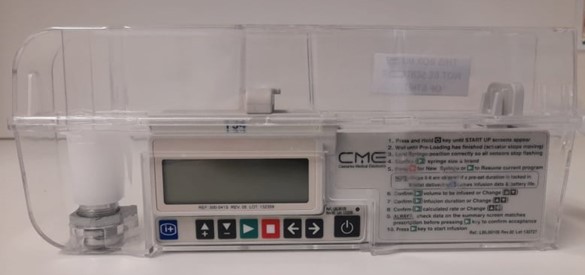- 📖 Geeky Medics OSCE Book
- ⚡ Geeky Medics Bundles
- ✨ 1300+ OSCE Stations
- ✅ OSCE Checklist PDF Booklet
- 🧠 UKMLA AKT Question Bank
- 💊 PSA Question Bank
- 💉 Clinical Skills App
- 🗂️ Flashcard Collections | OSCE, Medicine, Surgery, Anatomy
- 💬 SCA Cases for MRCGP
To be the first to know about our latest videos subscribe to our YouTube channel 🙌
Introduction
Symptoms such as pain, excess secretions and agitation are commonly seen in patients nearing the end of life.
Anticipatory medications are prescribed in advance, or ‘in anticipation’ of these symptoms developing. This ensures timely administration, minimising distress and discomfort.1
There are four main classes of anticipatory medication:
- Analgesia: for pain
- Anti-emetic: for nausea and vomiting
- Anxiolytic: for agitation
- Anti-secretory: for respiratory secretions
This article will cover how to prescribe anticipatory medications for patients nearing the end of life.
Prescribing anticipatory medications
Anticipatory medications are prescribed as subcutaneous injections (SC, injected under the skin) as patients nearing the end of life are often unable to take oral medications. They should be prescribed PRN, or ‘as needed’, rather than regularly.
When prescribing anticipatory medications, the following details should be included:
- Drug name
- Drug dose
- Route (SC)
- Indication for each medication: to make it clear which medication should be used for which symptom
- Frequency of delivery (e.g. 1 hourly)
- Maximum dose in twenty-four hours: to ensure safe levels of medication are given, this will also prompt regular reviews if a patient is requiring frequent doses
Unless the patient has previously received the medications, a low dose should be started and titrated up according to response.2
Managing common end of life symptoms
Choice of medication and starting doses vary depending on several patient factors including:
- Past medical history: for example, specific considerations for patients with Parkinson’s disease. Lower starting doses are used in frail patients.
- Organ dysfunction: renal and liver dysfunction affect the choice of medications and require lower starting doses
- Drug history: if patients are already on a background opiate their PRN dose should be calculated based on this, rather than using the dose for an opioid naïve patient
Preferred medications will also vary according to local guidelines. The examples below are based on the NHS Yorkshire and Humber guidelines.3,4
Although this article concentrates on anticipatory medications, it is also important to note that other treatments (including non-pharmacological) may be used in end-of-life care.
For example, if pain is caused by constipation, bowel care may be appropriate. In addition, non-pharmacological methods are equally important in managing symptoms, for example, psychological support, considering environmental factors for those who are agitated and use of fans for breathlessness.2
Pain
Pain can be caused by a variety of factors, ranging from disease-related pain (e.g. direct invasion by cancer) to pain from pressure sores.5
Assessment
Recognising pain is important, especially if patients are less responsive and therefore unable to articulate symptoms.
Speaking to a family member, carer or staff member who knows the patient can be helpful as they can recognise patterns of behaviour. Changes that might be observed that could indicate pain include:6
- Facial expressions such as grimacing
- Verbalisations such as moaning or shouting out
- Body movements such as guarding a particular area/part of the body
- Autonomic reactions such as increased heart rate or temperature
Examples of anticipatory medications
Common first-line agent for opiate naïve patients:4
- Morphine sulphate 1 – 2.5mg SC. Do not repeat within 1-hour, maximum 4 doses in 24 hours
- If reduced renal function (eGFR <50): Oxycodone 1 – 2 mg SC. Do not repeat within 1-hour, maximum 4 doses in 24 hours
For patients already on a background dose of opioid medication, the PRN anticipatory dose is generally 1/6th of the total subcutaneous background dose in 24 hours.
Example
Mr Y has been taking 30mg BD slow-release morphine but is now approaching the last days of life and is not able to swallow his usual medications. This is equivalent to 30mg SC morphine in 24 hours, and the PRN dose would be 5mg SC morphine (30/6).
Nausea and vomiting
Causes of nausea and vomiting may include constipation, medication side effects or biochemical disturbance (e.g. hypercalcaemia).2
Examples of anticipatory medications
Haloperidol 0.5 – 1.5mg SC. Do not repeat within 4 hours, maximum dose 3mg in 24 hours.
Agitation
Causes of agitation include pain, medications (side effects and withdrawal), constipation and urinary retention.7
As with pain, detecting agitation in a patient will rely on observing the patient and listening to those who are looking after them. Signs of agitation may include:
- Fidgeting/moving arms and legs
- Confused
- Vocalisations
Examples of anticipatory medication
Midazolam 2.5 – 5mg SC. Do not repeat within 1 hour, maximum 4 doses in 24 hours.
Secretions
With reduced levels of consciousness, patients may become unable to swallow or clear their normal respiratory secretions/saliva, resulting in pooling in the upper respiratory tract.
This can cause noisy breathing/a rattling noise as air passes over the pooled secretions. Offering reassurance to those looking after the patient that it is not a distressing symptom, as well as repositioning the patient may be helpful.2
Examples of anticipatory medication
Hyoscine butylbromide 20mg SC. Do not repeat within 1-hour, maximum dose 120mg in 24 hours
Syringe drivers
Syringe drivers are small battery-powered pumps used to deliver medications as a continuous subcutaneous infusion (CSCI) over a 24-hour period.
A syringe containing the appropriate medications is attached to a needle that is placed under the skin (into the subcutaneous tissue). An area is chosen which is convenient and comfortable for the patient, often the thigh, upper arm or abdomen.8

Indications for use of a syringe driver in patients nearing the end of life include:2
- Requiring two or more doses of any one of the anticipatory medications in a 24 hour period
- Being unable to take oral medications that need replacing (e.g. modified release opiates, anti-epileptic medications)
Continuous infusion provides a constant level of medication to the patient, which helps to achieve better symptom control.
Only medications that a patient has required are put into a syringe driver. Therefore, regular reviews are important as they may still require further ‘as required’ doses of medication on top of those in the syringe driver. These may be the same medications they are already receiving or one of the other anticipatory medications.
Example
Mrs X has pancreatic cancer and is in the last days of life. She has developed noisy breathing and agitation in the last 24 hours. She has required 3 x 20mg doses of hyoscine butylbromide and 2 x 2.5mg doses of midazolam. A syringe driver containing 60mg of hyoscine butylbromide and 5mg of midazolam over 24 hours is commenced.
You review Mrs X 24 hours after starting her syringe driver as above. Her family report that she has continued to have some noisy breathing, requiring two further doses of 20mg hyoscine butylbromide. She has also had 1 x 5mg midazolam for agitation and 1 x 5mg morphine sulphate for pain.
Therefore, you prescribe a new syringe driver containing 100mg hyoscine butylbromide, 10mg midazolam and 5mg morphine sulphate.
Syringe driver prescribing
Separate drug charts are usually used for prescribing syringe drivers. Many drugs can be mixed together safely in a syringe driver, but it is important to check compatibility. Further details can be sought from local guidelines, pharmacists or the local palliative care team. When setting up a syringe driver, most drugs are diluted in water for injection.
Key points
- Anticipatory medications are essential prescriptions for patients nearing the end of their life to ensure good symptom control
- Syringe drivers are commonly used to optimise symptom control by delivering a continuous subcutaneous infusion of medications that are needed
- It is important to thoroughly explain and discuss the use of anticipatory medications and syringe drivers with patients and their relatives
- Although medications play an important role, non-pharmacological methods are also important in managing symptoms
Reviewer
Dr Tammy Oxley
Palliative Care Registrar
Editor
Dr Chris Jefferies
References
- NHS Scotland. Scottish Palliative Care Guidelines, Anticipatory Prescribing. 2014, updated 2020. Available from: [LINK]
- Care of dying adults in the last days of life. December 2015. Available from: [LINK]
- NHS England – Yorkshire and the Humber End of Life Care Group. A guide to symptom management in palliative care. June 2019. Available from: [LINK]
- Moira Cookson, Sarah Mcdermott, Chris Toothill, Jason Ward – Leeds Community Healthcare NHS Trust. Symptom Management Guidance in the Last Days of Life. December 2017. Available from: [LINK]
- NHS Scotland. Scottish Palliative Care Guidelines, Pain Assessment. 2014, updated 2021. Available from: [LINK]
- Marie Curie. Palliative Care Knowledge Zone, Pain. 2021. Available from: [LINK]
- Marie Curie. Palliative Care Knowledge Zone, Agitation. 2021. Available from: [LINK]
- Marie Curie. Palliative Care Knowledge Zone, Syringe Pumps. 2021. Available from: [LINK]




